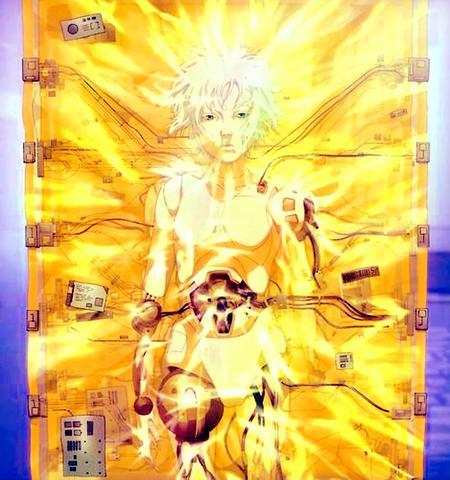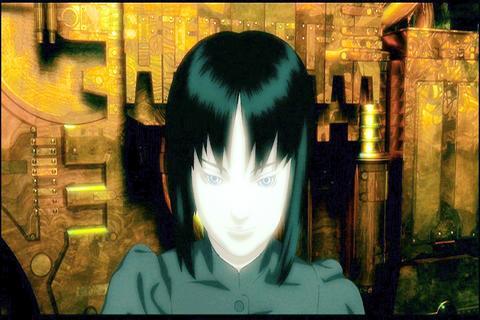Androids don't dream of electric sheep in Mamoru Oshii's hallucinatory meditation on life in the shadow of the machine world, Ghost in the Shell 2: Innocence. They dream of suicide, an unlikely act of violence that one android, or gynoid, a sexual pet with a tragic face and luridly flexible limbs, commits by clawing at its synthetic skin like a grieving widow.
In this plaintive, often stunningly beautiful anime, where sex dolls commit virtual seppuku against a swirl of film noir intrigue, philosophical speculation, eye-popping images and serious science-fiction cool, a toxic cloud hangs over all tomorrow's parties.

Written and directed by Oshii, the movie, which opens in Taiwan today, is a sequel to the Japanese filmmaker's 1995 anime, Ghost in the Shell, about a female detective who inhabits and then loses her artificial body.

PHOTOS COURTESY OF CROWN FILMS
Set in 2032, the new anime centers on her former colleague, the stone-faced cyborg Batou, a male cop in an unnamed government's antiterrorist division.
Called in to dispatch a gynoid gone amok, Batou enters with a ready gun and, in a photo-realist alley so authentically derelict that it's a surprise you can't smell it, comes face to face with a doll dressed in a peek-a-boo red kimono and a white gardenia. Push comes to catastrophic shove and, in time, what emerges is the familiar future-shock scenario in which machines seem more human than their human masters.
A study in earth tones and gum-shoe rectitude, Batou is a self-conscious cross between the detective played by Harrison Ford in Blade Runner and the runaway android played by Rutger Hauer. Drawn along the same solid lines as Hauer, Bateau comes clad in the classic world-weariness worn by Ford, one difference being that Oshii's tough guy keeps a basset hound. A floppy bundle of love and slobber, the dog is a link to the ghost (human identity) in Batou's machinery and, perhaps, as the hagiographic images of the hound suggest, something else.
Oshii squeezes charming laughs from Batou's relationship with the dog, but the hound's more essential function is to circle the film back to the fundamental question of what makes us human. Like Sean Young's replicant did with Ford's blade runner, the dog humanizes the hero and becomes the occasion for some philosophical riffing.
Although Oshii doesn't try to answer the question of existence, in between plot points that take Batou from a forensics lab to a yakuza den and rapacious doll company called Locus Solus (Latin for a solitary place), the filmmaker tosses in quotations from Descartes and Milton, nods to Jakob Grimm, Isaac Asimov and Jean-Luc Godard, lines from Psalm 139 and, most startlingly, references to the German artist and Surrealist fellow traveler, Hans Bellmer.
Inspired by Tales of Hoffman, Jacques Offenbach's opera about an automaton, Bellmer began constructing, then photographing, his fetishistic ball-joint dolls in the early 1930s. Machine-made rather than handcrafted, the dolls in Innocence are more streamlined than Bellmer's and significantly less perverse, but their ball-joints construction gives them a similar off-kilter, disturbing physiognomy.
The dolls in Innocence have bodies as bendable as that of a G.I. Joe toy, having been designed for sexual pleasure, while their faces remain frozen in Barbie-like supplication. Like many artists, Oshii clearly derives enjoyment from the image of the female form in all its mutations, but in this film that delight also comes with a little politics. Unlike Bellmer's dolls, Oshii's dolls sever their bonds and the occasional male head.
The bumps may be a function of the translation; whatever the case, they do nothing to diminish the delights of this exquisitely textured film. A seamless blend of old and new animation techniques, with the characters rendered in traditional 2D and the backgrounds in vivid 3D (computer generated imagery), Innocence doesn't just reveal a wealth of visual enchantments; it restates the case that there can and should be more to feature-length animations than cheap jokes, bathos and pandering. It also proves the point that 2D animation remains a vital technology.
But never mind the techno-babble. What matters most here isn't the number of gigabytes it took to make the feathers on a seagull look palpably real. It's the way the camera narrows in on the bird's eye as if Oshii believed the answers to the film's questions might be found in the natural world and its brutalized remnants, in that solitary place beyond the machines.
In one of the film's most hypnotically lovely set pieces, a kaleidoscopic cavalcade featuring enormous animal effigies, grimacing warriors and shimmering golden pagodas, he also suggests that the past may offer up yet other answers. In Innocence past and present, ghost and machine jostle alongside one another, while the mysteries of the universe, seen in the swirl of cream in a cup of coffee and spirals of flying gulls, continue.

June 23 to June 29 After capturing the walled city of Hsinchu on June 22, 1895, the Japanese hoped to quickly push south and seize control of Taiwan’s entire west coast — but their advance was stalled for more than a month. Not only did local Hakka fighters continue to cause them headaches, resistance forces even attempted to retake the city three times. “We had planned to occupy Anping (Tainan) and Takao (Kaohsiung) as soon as possible, but ever since we took Hsinchu, nearby bandits proclaiming to be ‘righteous people’ (義民) have been destroying train tracks and electrical cables, and gathering in villages

Dr. Y. Tony Yang, Associate Dean of Health Policy and Population Science at George Washington University, argued last week in a piece for the Taipei Times about former president Ma Ying-jeou (馬英九) leading a student delegation to the People’s Republic of China (PRC) that, “The real question is not whether Ma’s visit helps or hurts Taiwan — it is why Taiwan lacks a sophisticated, multi-track approach to one of the most complex geopolitical relationships in the world” (“Ma’s Visit, DPP’s Blind Spot,” June 18, page 8). Yang contends that the Democratic Progressive Party (DPP) has a blind spot: “By treating any

Swooping low over the banks of a Nile River tributary, an aid flight run by retired American military officers released a stream of food-stuffed sacks over a town emptied by fighting in South Sudan, a country wracked by conflict. Last week’s air drop was the latest in a controversial development — private contracting firms led by former US intelligence officers and military veterans delivering aid to some of the world’s deadliest conflict zones, in operations organized with governments that are combatants in the conflicts. The moves are roiling the global aid community, which warns of a more militarized, politicized and profit-seeking trend

This year will go down in the history books. Taiwan faces enormous turmoil and uncertainty in the coming months. Which political parties are in a good position to handle big changes? All of the main parties are beset with challenges. Taking stock, this column examined the Taiwan People’s Party (TPP) (“Huang Kuo-chang’s choking the life out of the TPP,” May 28, page 12), the Democratic Progressive Party (DPP) (“Challenges amid choppy waters for the DPP,” June 14, page 12) and the Chinese Nationalist Party (KMT) (“KMT struggles to seize opportunities as ‘interesting times’ loom,” June 20, page 11). Times like these can